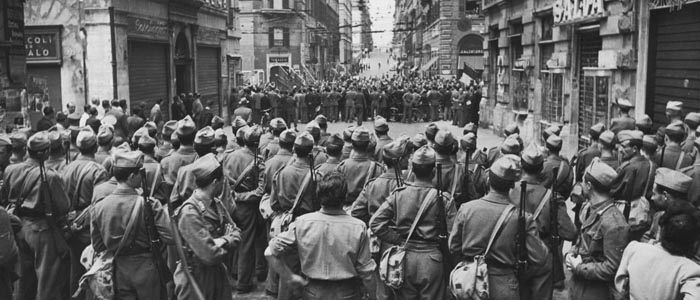As a third-generation Italian American, Italy’s history and current affairs has remained a major fascination for me.
Many Americans ponder what life might have been like had their families remained in their home countries instead of risking everything to travel across great oceans to the Land of Opportunity.
The more I’ve learned about modern Italy, the more thankful I’ve become that my family left that country of social and political backwardness.
With this in mind, two international headlines today catch my eye:
- Italian Prime Minister Silvio Berlusconi has been accused by an organized crime hit-man of having made verbal commitments to the notoriously violent Sicilian organized crime organization Cosa Nostra over 15 years ago
- 22 Year Old American college student Amanda Knox is sentenced to 26 years in prison for murder in spite of a complete lack of evidence, largely due to an allegedly corrupt, megalomaniac judge
On such a day, one wonders how a country like Italy has become such a political cesspool of corruption and crime. And the question is exacerbated when contrasted with the likes of modern Germany — considering both states were forced to begin completely anew after their implosion and defeat in World War II. The answer is revealed in Italian history after the fall of Mussolini.

The Italian anti-fascist resistance movement that first appeared in 1943 would become a revealing indication of the erratic political future of post-Mussolini Italy. This Italian “civil war” that raged from 1943 until the end of World War II in 1945 shattered the lives of thousands of innocent Italian citizens who so desperately hoped to see fascism finally eradicated. The internal conflict also prolonged food shortages, set off a flurry of Communist-led labor strikes and social unrest, and further instigated the deep historical divisions between the Italian North and South (Duggan 238-239, Cardoza 152).
While the Italian partisans primarily fought the Nazi occupying forces throughout Italy and fascists in the Republic of Salò, the 300,000-plus armed fighters of the Partisan movement would soon find themselves dragged into the realm of organized politics, poised to take control of the government, but quite unsure about how to tackle three major looming issues:
- To purge or grant amnesty to former Italian fascists and their sympathizers;
- What type of government type and constitution should be created; and
- How to solve the vast array of economic woes that burdened the state (Duggan 245).
The new government’s failure to answer these questions would foreshadow an unstable future for Italian politics.
The Italian anti-fascist resistance movement first surfaced in 1943. The resistance was set forth by self-governing militiamen, an armed partisan force that exploded in size after the signing of the Armistice with Italy, the state’s official surrender to the Allies in World War II on September 8, 1943. At this time, the once great “Duce,” Benito Mussolini, was powerless, sick and living in isolation in Northern Italy (Cardoza 153). While some remained loyal to Mussolini and the fascist cause until their deaths, the fascist leadership literally disappeared overnight, spurring no foreseeable resistance from the Mussolini-fascists; hundreds of thousands of disenfranchised ex-fascists soldiers soon turned on the once-glorious cause.
The resistance groups carried out dozens of acts of sabotage and guerrilla warfare against German troops and fascist sympathizers (Cardoza 152-154). In 1945, with the Allied forces pressing both north through the Italian peninsula and east from Normandy, France, the Italian partisan resistance staged numerous rebellions in the Nazi-controlled North, attempting to establish anti-fascist provisional local governments (Cardoza 156).
Led by the Committee of National Liberation of Upper Italy (CLNAI), the large insurrection coincided with a renewed Allied offensive, ending with the final surrender of the Nazi forces (Duggan 243). However, much like the “squadristi” Fascist Blackshirt guerrillas that brought both Mussolini and Fascism to power in the 1920s, so too did the partisans find themselves drawn into organized politics (Duggan 241).

Five primary political groups emerged in the post-Mussolini era of 1944-1945:
- The largest was the Communist Party, claiming over 50,000 active and inactive resistance fighters. As fascism began to crumble in 1943, some 3,000 Communist Party leaders were freed from prison, much to the chagrin of Allied leaders who feared a Communist takeover of Italy; the Communist Party leaders “immediately set to work winning support among partisans and factory workers” (Duggan 243). In the spring of 1943, some 100,000 workers in the northern Italian city of Turin went on strike, instigating other protests across the North. Underground Communist Party organizers initiated the strikes, attempting to orchestrate the Marxist revolution of the proletariat class (Duggan 238).
- The Action Party was a liberal, democratic group that was led by “high-minded” intellectuals who sought to quickly heal the “moral” wounds that fascism had caused, but not before purging former party members and officials who caused those wounds.
- The Christian Democrats relied heavily upon support from the Italian clergy.
- The Italian Socialists were in alliance with the large Communist Party.
- The Liberal partisans were a much smaller organization of monarchists (Duggan 241-243).
The Italian partisans sought to officially assume control of the government in 1945. They hoped to resolve three key issues that plagued the new, democratic Italy.
- First, should the government systematically purge or attempt to grant amnesty to former Italian fascists and their sympathizers? Indeed, deciphering who was a fascist, let alone deciding who deserved punishment or death for being one, would be an incredibly difficult feat (Duggan 245).
- Second, the new government sought to “fix runaway inflation, rampant unemployment, reconstruction,” and other structural issues, including the notorious North-South gap (Duggan 244-45).
- Lastly, what type of government should the new Italy pursue? In 1945, the partisans had unanimously proudly agreed that the new order in Italy would be built upon the “values of the Resistance”, those being “democracy, freedom, honestly, accountability, openness, and modernity” (Duggan 244).
But pragmatism would soon give way to the “values of the Resistance.”
The “wind from the North” that partisans believed would cleanse the Italian peninsula of its tarnishes from fascism did not quite come to pass. Additionally, the “new order” that partisans so highly spoke of hardly came about: “the desire from moral renewal… was soon frustrated” (Duggan 244). The “wind” never blew far enough to touch the Italian South, which, because it had been liberated by the Allies some months earlier, saw no pro-liberation, anti-fascist resistance movement of its own develop, and thus, no new ruling elite emerged to take power away from the old landlords.
However, the partisans provided “an important contribution to the defeat of fascism” (Duggan 244-45). Vital infrastructure of the “unliberated North” had been protected from sabotage and destruction by the Nazis due to the hasty and successful uprisings by the partisans in 1944 and 1945. Additionally, Allied support to the partisans greatly contributed to the final defeat of both fascism in Italy, and Nazism in Germany. But the most important circumstances of the Italian resistance movement were not political or militaristic, but rather on a social and individual level.

The monumental effect wreaked upon ordinary Italian citizens by the Italian resistance movement and the pure chaos that ensued after the fall of Mussolini and the fascists is beautifully depicted in the 1982 film La Notte di San Lorenzo (English: Night of the Shooting Stars) by Paolo and Vittorio Taviani. In the film, which takes place in 1944, a group of Italians flee their Northern town of San Martino after hearing rumors that the German troops are planning to destroy it. They hope to find their potential liberators, American troops, and find safe-shelter from fascist Blackshirt gangs and Nazi soldiers. The movie depicts scenes of horror and disorder in such a stressful fashion that leaves the viewer feeling notably sick and anxious.
In Italy at this time, families, friends and neighbors found themselves harassing, attacking, and even killing one another strictly due to differences in political affiliation. Truly, the Taviani brothers’ film portrays inhuman, hell-like conditions for Italians living in Northern Italy during the time of the resistance movement.
Conclusions
The Italian resistance movement that resulted in 1943 would become a revealing indication of Italy’s irregular political future. The resistance, which primarily consisted of former fascist soldiers and prisoners, undermined the German occupation of Italy, aided the Allies in liberating their Italian homeland, and finally defeated the remnants of Mussolini’s fascist regime. With those successes in mind, it is important to recall the shortcomings that resulted from the rise of partisans from 1943-1945. “The symbols, the rhetoric, and even the constitution changed; but most of the old personnel and many of the former institutions remained untouched” (Duggan 245).
Indeed, it was the Allied Forces’ inability to liberate Italy in a timely fashion that allowed a Nazi takeover of the North and the capital city of Rome; this caused the rise of the partisans, who sought to fill the forthcoming power vacuum that would inevitably result with the approaching conclusion to the Second World War. In the years following the 1945, Italy saw disappointing political, social, and economic continuity and stagnancy rather than sweeping changes in the name of “democracy, freedom, honesty, accountability, openness, and modernity” — those values that the Resistance hoped to instill.
From 1945-1948 the Italian political system would become incredibly polarized, setting ‘reality’ even further apart from the once glorious ideals of the Resistance. Almost unfathomably, these few critical years created an unstable trend for Italian politics that endures today, over sixty years later.